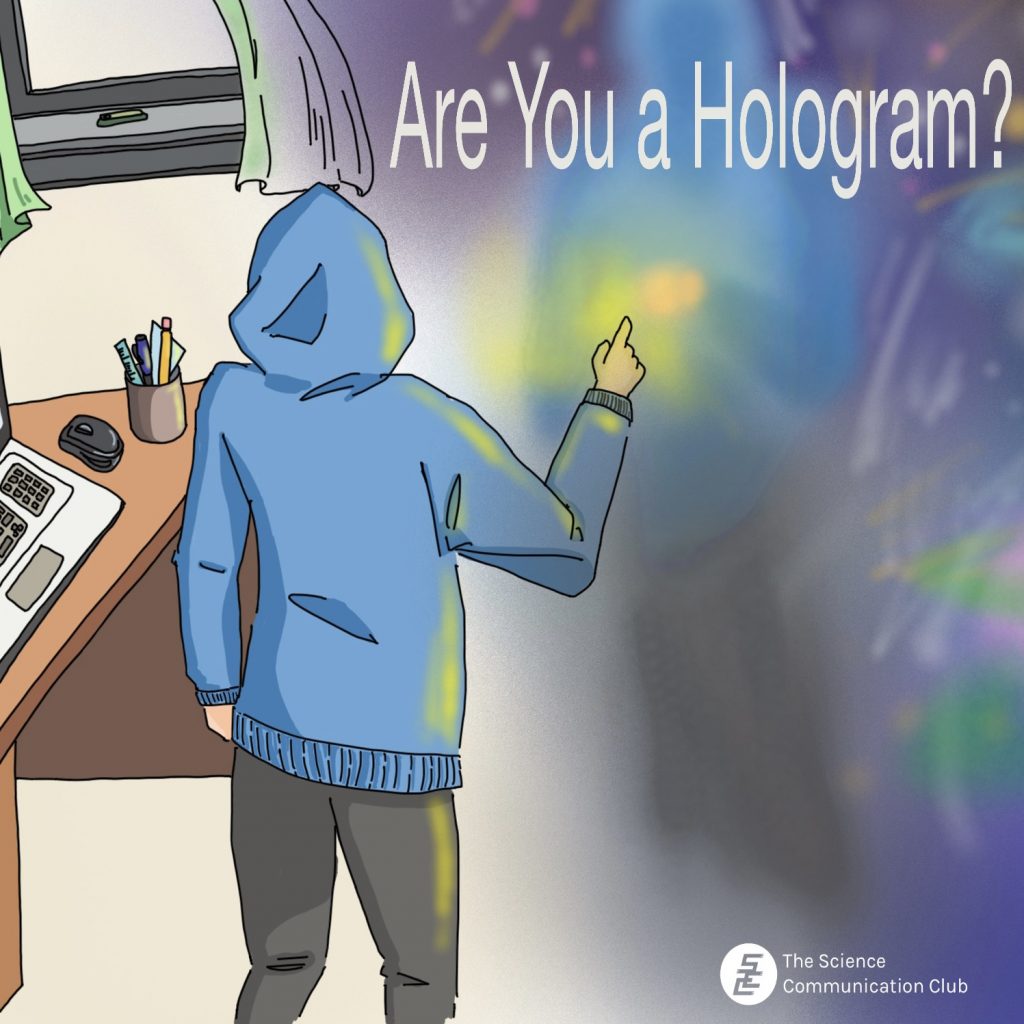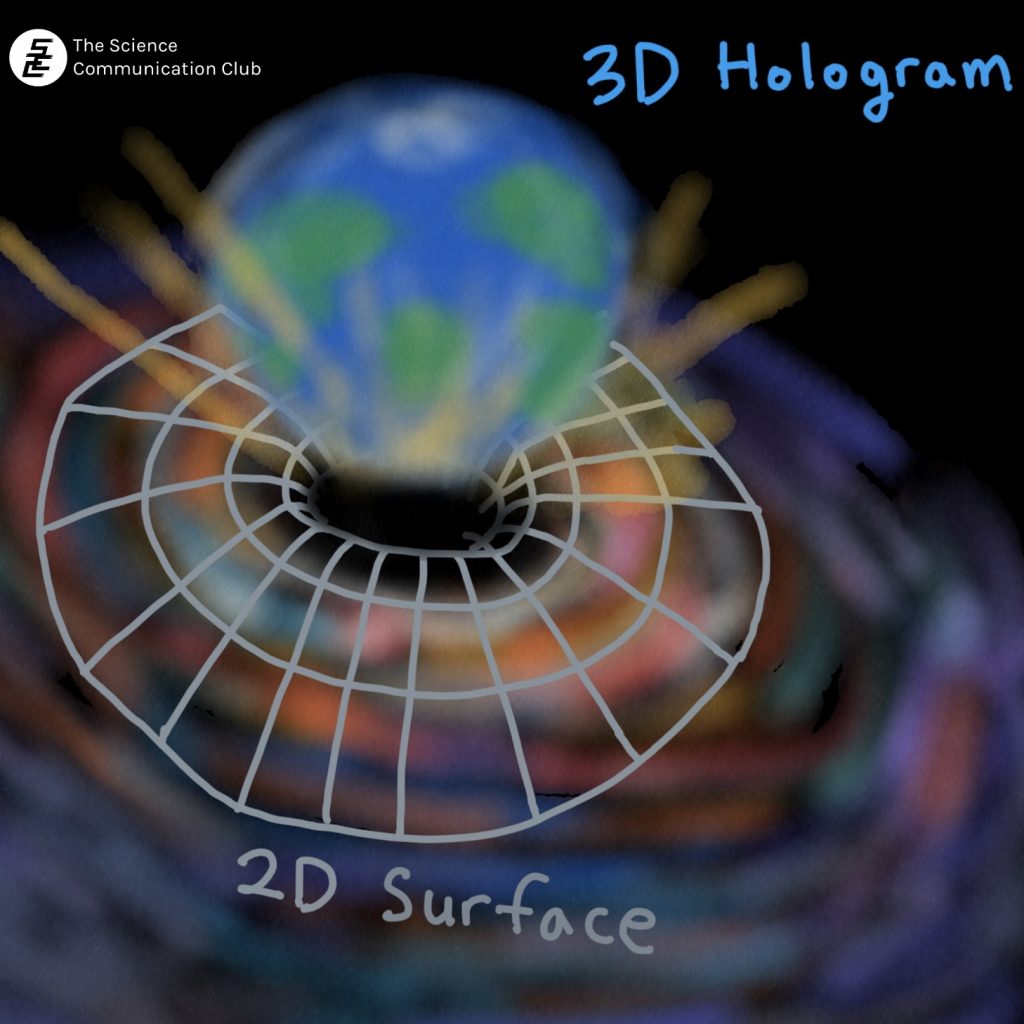
Written by Shoaib Shahid
Illustrated by Haely Oh
It was 1915 when our resident genius Albert Einstein published his theory of General Relativity. As Christmas trees stood tall and families reunited for the holidays that year, Einstein received a letter from a German soldier on the Russian front. This soldier was Karl Schwarzschild, who, amongst the guns and shouts, found a solution to Einstein’s theory that directly predicted black holes.
The year is 2023 and black holes are all the rage. They have garnered a monstrous reputation as heartless creatures that swallow everything around them. While all this notoriety has grown, a mesmerising idea has bloomed behind it. The idea that you, me, and our entire universe is a hologram. Yes, you read that right. Let us not stay here. Rather than spiral into a crisis, it is better we understand.
To understand, we go back in time once again. This time to the England of 1974, where the great physicist Stephen Hawking has just announced that black holes radiate energy. Aptly, this emitted radiation is now known as the Hawking Radiation. We can understand the idea with some Quantum Physics and General Relativity. Within Quantum Field Theory exist virtual particles. These are pairings, of a particle and its anti-particle, that come into existence from a vacuum and then disappear just as quickly. But if a pair pops up near a black hole, the immense gravity swallows one of the particles. The swallowed particle gains negative energy (yes, negative energy) and removes some of the mass from the black hole. The other particle, all lonely, moves away with positive energy. This particle is Hawking Radiation. In this excruciatingly slow process, the black hole essentially evaporates away.
As with any advancement in physics, more questions and debates arose. Hawking’s discovery implied that black holes conserve energy, but information disappears in them. This issue came to be known as the information paradox and sparked a fierce battle between some of the revered titans of physics. Opposing Hawking were Leonard Susskind and Gerard ‘t Hooft, amongst others. They argued that Quantum Physics did not allow for information to just disappear. Before moving forward, it is important we understand what physicists refer to when they talk about “information.”

Information can basically be considered the difference between objects. When you look at a lamp and a fistful of peanuts, you recognize the difference. Information is what differentiates the lamp from the fistful of peanuts. According to Hawking, a black hole was indifferent between a lamp entering it and peanuts entering it. It absorbs the energy, but the objects are no longer distinguishable. This did not sit right with Susskind and group who considered it to be a basic principle that information is conserved in our universe. Two different things cannot become the same thing. I will give you a spoiler here. Susskind and ‘t Hooft ended up winning the debate. Hawking gracefully yielded.
The group’s ingenious solution to the information paradox brings us one step closer to… us not being real. They suggested that all information that goes past the edge of the black hole, known as its event horizon, is preserved on its surface. So, even though the black hole swallows the information, for an outsider observer like us, it is still in our universe. It is spread across the event horizon. In fact, we can calculate the amount of information stored in a black hole by measuring its surface area. The larger the surface area of a black hole, the more information it is expected to contain.
This seems a good time to bring holograms in the picture. Usually, a hologram is a two-dimensional sheet with information scrambled on it. We pass a light through it which results in a three-dimensional representation. What about a black hole then? The information stored on the surface of a black hole represents everything that is inside it. Seems harmless enough so far, right? Turns out that this principle, the holographic principle, can be applied to any object. Let’s take your bedroom as an example. One would think that the volume of your room would be a good measurement of the amount of information in it. But, defying intuition, it is actually the surface area of your room that measures the amount of information in it.
We have traversed a tremendous distance from the event horizon to your bedroom. Let us take an even longer trip to the edge of our universe — the horizon of our universe. As with the surface of the black hole, the two-dimensional surface of our universe’s horizon may hold all the information within our universe. This would make our universe a three-dimensional hologram of its two-dimensional surface. You and I, we would both be holograms of another you and I that reside on the two-dimensional horizon.
We have taken a long path to this point. From black holes to the information paradox to the holographic principle. A whole century worth of physics. I don’t know if that lessens the shock of such a possibility being disclosed. Here, I will leave you with a choice. In such a universe, is the real you on the two-dimensional horizon or is the real you, well, you?
Sources
- Susskind L. 2009. The Black Hole War: My Battle with Stephen Hawking to Make the World Safe for Quantum Mechanics. New York, NY: Back Bay Books.